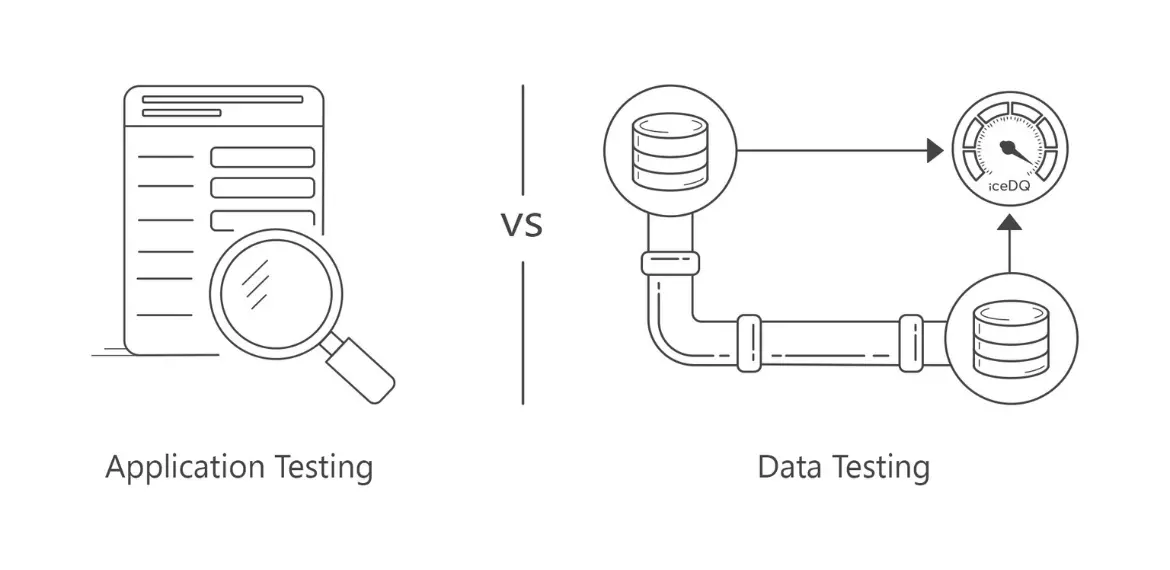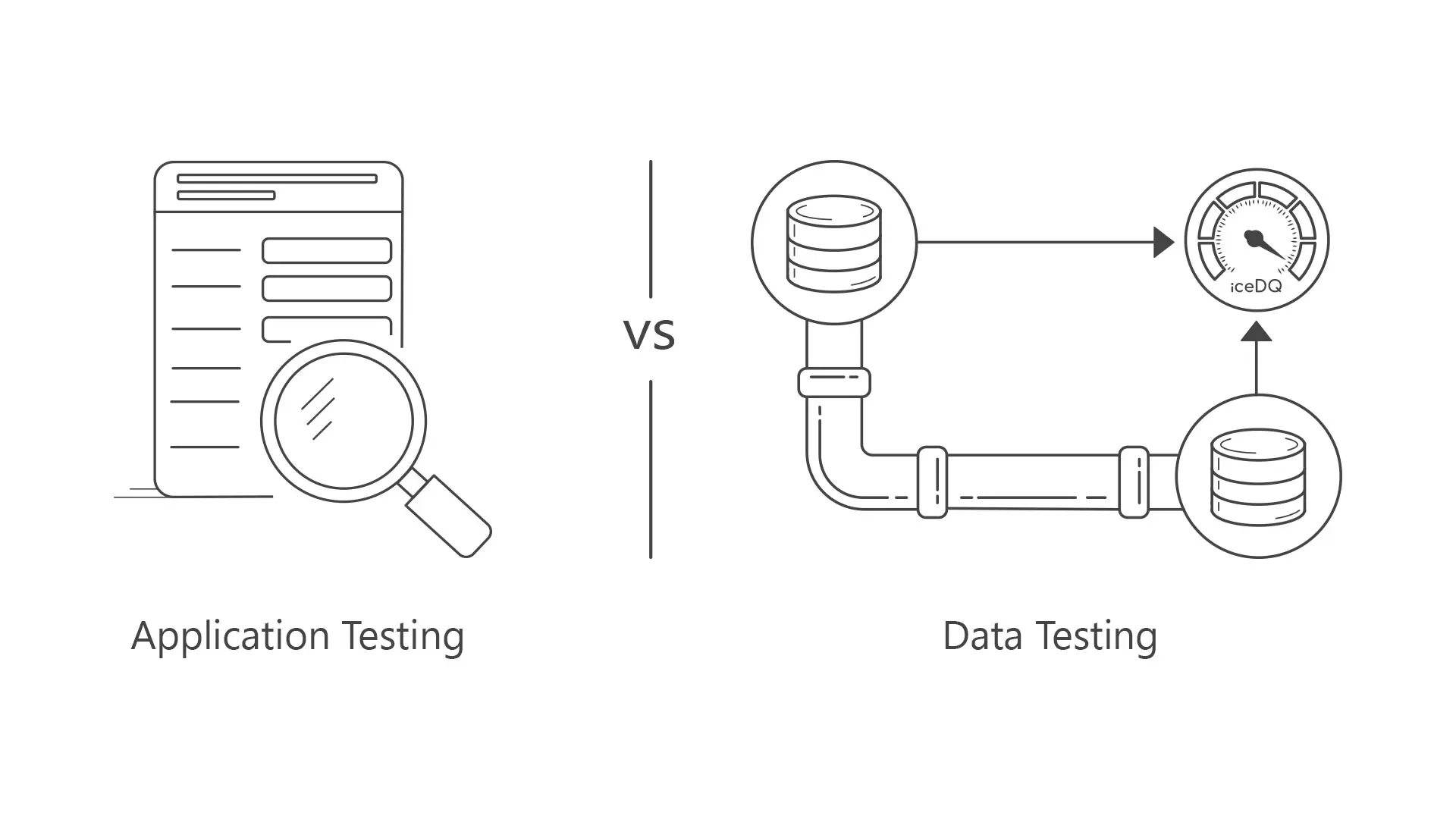
Introduction
This blog will explore the critical distinctions between application testing vs data testing, common mistakes with data testing, and reveal the consequences of neglecting it.

Testing is a critical step for any software development project. Web applications, or mobile apps are tested to ensure proper functionality of the UI. But what about data-centric projects such as data warehouses, ETL, data migration, and big data lakes? Such systems involve massive amounts of data, have long running processes, and unlike applications, they lack screens. In such projects how does testing work?
Data Testing vs Application Testing
At a high-level data testing and application testing both share a common goal of ensuring functionality of a system, however on a closer look, it reveals that they have very distinct focuses and methodologies. Here is a quick list of differences for your reference.
Project Types:
- Application testing spans a wide spectrum of web apps and mobile apps.
- On the other hand, data testing zeroes in on projects like data migration, Data pipelines, data warehouses.
Testing Objective and Focus:
- Application Testing addresses everything from user interface intricacies to scripting, APIs, functions, and code integrity.
- For data testing, the emphasis is on ETL/data processes, process orchestration, and unique attention to data integrity sets it apart as a specialized discipline.
Data Volume:
- Application Testing spans various dimensions, one of them being data. But in the scope of application testing data involvement is extremely limited to a few records created by a transaction.
- Data testing however, puts a spotlight on the critical nuances of data. The contrast is stark: compared to application testing, data testing involves millions and billions of records.
Certification:
- In application testing the certification focus is on code integrity.
- Data testing is essentially designed to certify data integrity.
Expected vs. Actual:
- Application testing compares the actual behavior of user interfaces and scripts vs expected.
- Data testing navigates the complex terrain of data integrity, migration accuracy, and the nuances of big data.
Performance Testing:
- In application testing the focus is on the speed at which the UI or the underlying functions respond to a request. It is in the realms of microseconds. On the other hand, performance testing for Data is in minutes and hours.
- For data testing the performance is usually calculated by rows processed per second. It is usually computed in the time required to read data, transport data, process data and load data in a target database. The loading time is further calculated in terms of update, insert, and delete speed.
Employee Skillsets:
- Both processes demand a skill set that combines technical acumen and a deep understanding of the tools at play. Application Testing requires proficiency in user interface testing, scripting, and tools like Selenium/JMeter. Application testing requires understanding screen behavior, and utilizing tools tailored to the unique challenges presented by data.
- In contrast, data testing necessitates expertise in handling data sources and target data, SQL, Data Models, and Reference data. Proficiency in scripting and code-level understanding is essential for application testing, while data testing demands a command over SQL for effective data manipulation and validation.
Testing Tools:
- Application testing often employs tools like Selenium and JMeter.
- Data testing leverages specialized tools like iceDQ for comprehensive data quality assurance.
Top Data Testing Mistakes
At the heart of the issue lies a fundamental misunderstanding – the perception that application testing and data testing can be treated interchangeably.
- Ignore Data Testing: Organizations often neglect data testing. A QA professional with an application background does not understand data testing, while the data engineers are not classically trained in testing.
- Lack of Dedicated Data Testing Team: The lack of a dedicated team will result in knowledge gaps. Dedicated teams is essential to properly train and acquire proficiency.
- Application Testers for Data Testing: Just because someone is skilled in application testing does not mean that the person will have the know-how of data testing.
- Manual Data Testing: Automation has become the mantra for efficiency in software testing, but this mantra is often focused more on application testing. Automated UI tests and functional checks take centre stage, leaving data testing to be more of a manual process. The absence of automation in data testing not only hampers efficiency but also introduces the risk of human error.
- Data Sampling: In the absence of automation, organizations resort to manual data testing, a daunting task when faced with millions of records. Manual testing becomes a mammoth task to undertake, prone to errors, inconsistencies, and a significant drain on resources. The sheer volume of data makes it humanly impossible to ensure comprehensive testing, forcing the testing team to resort to testing sample data rather than the entire dataset.
- Misuse of application testing tools for data testing: While tools like Selenium and JMeter excel in UI and functionality checks, testing data pipelines demands specialized tools. The mismatch not only results in inefficiencies but also fails to address the unique challenges posed by data-centric projects.
- Low /No Budget for Data Testing: Organizations, in pursuit of flawless user experiences, often channel a significant portion of resources towards application testing tools and frameworks. Meanwhile, data testing, which operates in the complex terrains of data migration testing, ETL testing, data warehouse testing, database migration testing and BI report testing is left with a fraction of the QA budget.
- In-house Scripts or Frameworks: Some organizations realize the distinct nature of data testing and attempt to build in-house frameworks. However, this approach often has more disadvantages than advantages. In-house frameworks, while tailored to specific needs, may lack the scalability required for projects dealing with millions of records and complex data structures. The inefficiencies in this approach become apparent with the growth in data volumes and complexity.
Consequences of Ignoring Data Testing
- Cost and Time overruns
- Complete failure of projects
- Data Quality issues in Production
- Compliance and regulatory risks
- Reputation Risks
Conclusion
To summarize the difference, while Application Testing and data testing share the overarching goal of ensuring the robustness of a system, they operate in distinct realms. Application Testing spans the broader landscape of application functionality, whereas data testing homes in on the intricate dance of data within the system. Understanding and appreciating these differences is crucial for organizations aiming to fortify their digital transformation.
Recognizing the critical distinctions between application testing and data testing is the first step towards comprehensive Quality Assurance. Organizations must recalibrate their approach, acknowledging the unique requirements of data testing and allocating resources, budgets, and automation efforts accordingly.
Embracing specialized tools like iceDQ which is a low code-no code solution for testing your data-centric projects is key to building software that stands the test of both user experiences and data integrity.
For more details please visit our blog: https://bit.ly/3SWpgYs
Author

Sandesh Gawande is the CTO at iCEDQ (Torana Inc.) and a serial entrepreneur.
Since 1996, Sandesh has been designing products and doing data engineering. He has developed and trademarked a framework for data integration – ETL Interface Architecture®. He consulted various Insurance, Banking, and Healthcare. He realized, while companies were investing millions of dollars in their data projects, they were not testing their data pipelines. This caused project delays, huge labor costs, and expensive production fixes. Herein lies the genesis of the iCEDQ platform.
iCEDQ is an EXPO Gold Sponsor at EuroSTAR 2024, join us in Stockholm